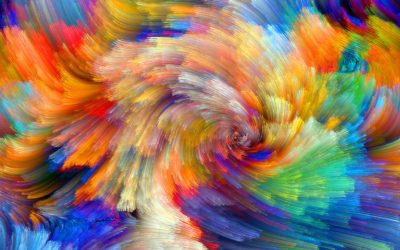Goethe is a fascinating character from history, poetic and scientific, a renaissance man. His ideas about color fell more on the poetic side of things, as he took no scientific or mathematical measurements of color into account in arranging his ideas. His theories are wholistic, sensory based, and perceptual.
What piques interest the most about his theories is his idea of light as an equilibrium of light vs. dark, with red being the pinnacle or the perfect equilibrium.
The darkest space would offer no insight to color, there would be no perceivable color. The same is true in the brightest of lights, there would be no color. It reminds me of the different types of color: luminous and reflective. If light is shining colors at us, all colors combined are white. If light is bouncing off of something and hitting our eyeball, all colors combined are black. All colors are both black and white, so in the middle must be something important. That is red, to Goethe.
The first color on the way to red from lightness is yellow. The first color on the way to red from darkness is blue. Every other color is some degree of separation in lightness or darkness from this state.

With axis lines denoting opposite values of lightening and darkening, the three essential colors as points on the triangle, and the intermediaries making up points along the enclosing circle, this is one method of representing the relationships of color.
Colors not represented here are white, black, and those that create shades and tints when mixed with white and black. These also happen to be representative of the first three colors that any language develops. The first two colors for which all languages have a word are white and black, then red. The lightening, the darkening, and the equilibrium point. It is interesting how language mimics this organizational method of Goethe’s. Language, like Goethe’s ideas about color, are matrix-based, they develop holistically in regards to human perception, not according to mathematical measure or scientific study.
Here is a similar triangle, with the first three colors of language and the essential elements of the color spectrum of Goethe represented along the triangular points. Axis lines here represent opposites, again, with mixtures along the outer circle. Interestingly, some of the last colors to develop into language in all cultures across the globe are pink, grey, and brown.

The two structures can connect at the central node of the equilibrium point: red. In a way, you could think of the upper circle as representing the highest order and logic, since the terms for these colors develop latest in language, while the bottom circle would represent more chaotic and primal energies, since they develop first in language.

Another way to represent these colors and their relationships is in the form of a double octahedron. Here, we also divide the colors into warm and cool, lightening and darkening.

The association with energies, ordered and chaotic, light and dark, aren’t the only energetic associations we can make. In accordance with language and universality, when taking stock of the cultural associations of planets with certain colors in various time periods in the history of the planet, the most common associations are below:

We, therefore, come up with a somewhat different set of associations with colors and the planets than is commonly found elsewhere, based on Goethe’s reasoning and a similarly envisioned philosophy of language.
Planets, colors, and values have commonly been associated with different elements, specifically metals. Here, the most commonly attributed metals to each planet and color are as follows:

The work herein is purely processed in my brain from Patrice Guinard, who was kind enough to leave these bread crumbs and imagery on her site. I am grateful to her.
Two bread crumbs to follow up on in the sequel to this post are these:
“Thus we discovered that the seven metals of the alchemical tradition, i.e. silver, mercury, gold, lead, iron, copper and tin, produced very particular variations in the DNA molecule.” Étienne Guillé
And this:
“I salute the jewellers…” Patrice Guinard
Treat the jewel of your being as a precious gem! Find your optimal wellness at Phoenix Aurelius’ lab and apothecary where the spagyrics, remedies, and supplements you need have that small-batch, hand-crafted, and wild-crafted health boost for your entire being!


Comments are closed